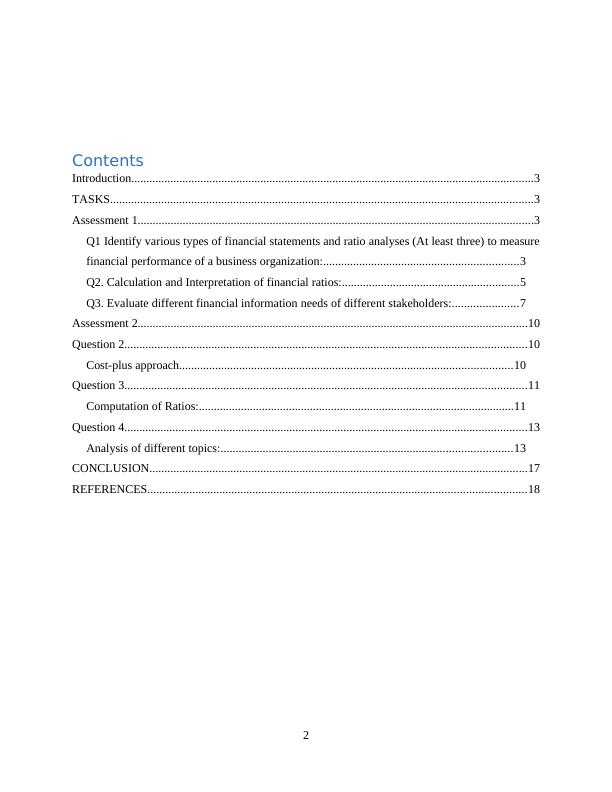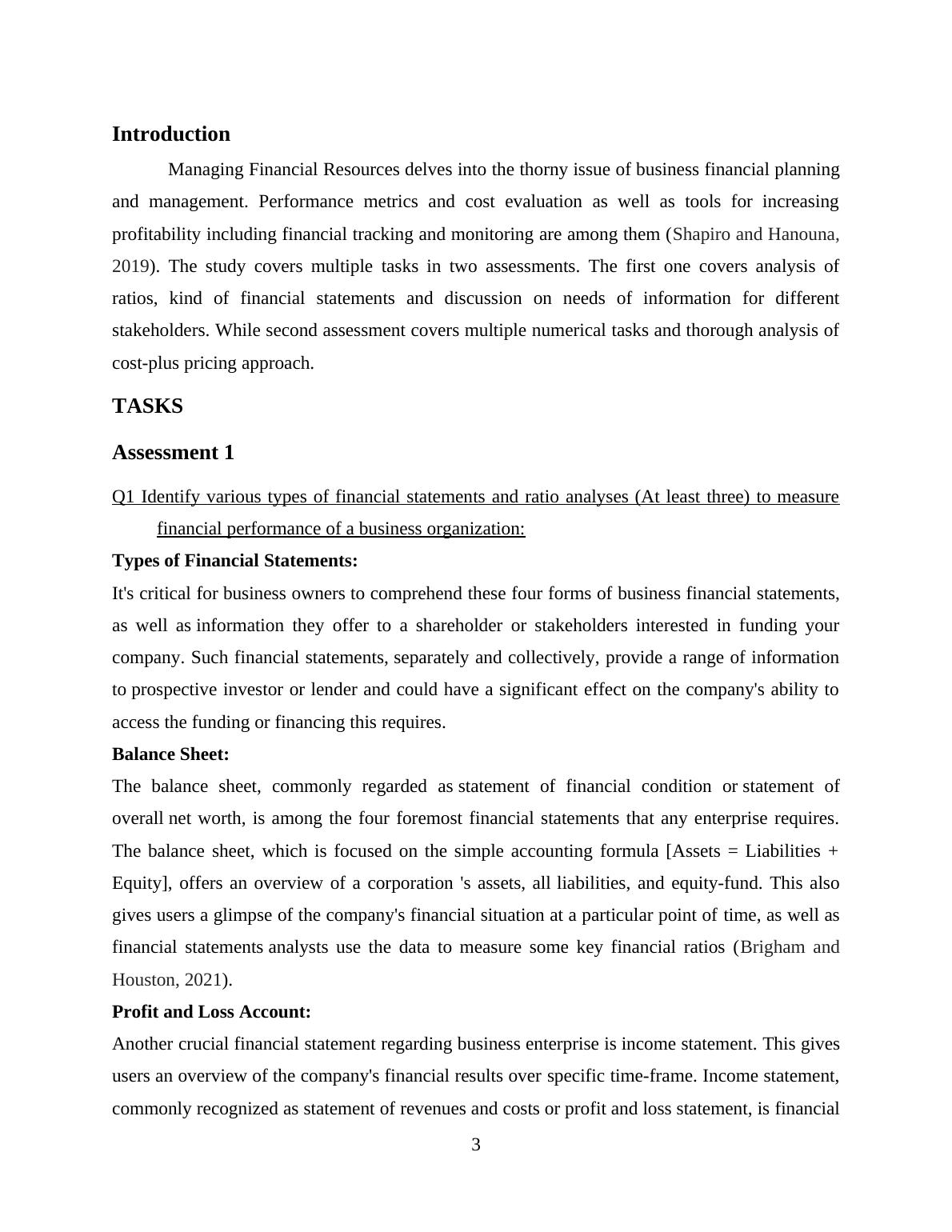Managing Financial Resources
19 Pages4660 Words1 Views
Added on 2022-12-14
Managing Financial Resources
Added on 2022-12-14
ShareRelated Documents
Managing Financial Resources
1
1

Contents
Introduction......................................................................................................................................3
TASKS.............................................................................................................................................3
Assessment 1....................................................................................................................................3
Q1 Identify various types of financial statements and ratio analyses (At least three) to measure
financial performance of a business organization:.................................................................3
Q2. Calculation and Interpretation of financial ratios:...........................................................5
Q3. Evaluate different financial information needs of different stakeholders:......................7
Assessment 2..................................................................................................................................10
Question 2......................................................................................................................................10
Cost-plus approach...............................................................................................................10
Question 3......................................................................................................................................11
Computation of Ratios:.........................................................................................................11
Question 4......................................................................................................................................13
Analysis of different topics:.................................................................................................13
CONCLUSION..............................................................................................................................17
REFERENCES..............................................................................................................................18
2
Introduction......................................................................................................................................3
TASKS.............................................................................................................................................3
Assessment 1....................................................................................................................................3
Q1 Identify various types of financial statements and ratio analyses (At least three) to measure
financial performance of a business organization:.................................................................3
Q2. Calculation and Interpretation of financial ratios:...........................................................5
Q3. Evaluate different financial information needs of different stakeholders:......................7
Assessment 2..................................................................................................................................10
Question 2......................................................................................................................................10
Cost-plus approach...............................................................................................................10
Question 3......................................................................................................................................11
Computation of Ratios:.........................................................................................................11
Question 4......................................................................................................................................13
Analysis of different topics:.................................................................................................13
CONCLUSION..............................................................................................................................17
REFERENCES..............................................................................................................................18
2

Introduction
Managing Financial Resources delves into the thorny issue of business financial planning
and management. Performance metrics and cost evaluation as well as tools for increasing
profitability including financial tracking and monitoring are among them (Shapiro and Hanouna,
2019). The study covers multiple tasks in two assessments. The first one covers analysis of
ratios, kind of financial statements and discussion on needs of information for different
stakeholders. While second assessment covers multiple numerical tasks and thorough analysis of
cost-plus pricing approach.
TASKS
Assessment 1
Q1 Identify various types of financial statements and ratio analyses (At least three) to measure
financial performance of a business organization:
Types of Financial Statements:
It's critical for business owners to comprehend these four forms of business financial statements,
as well as information they offer to a shareholder or stakeholders interested in funding your
company. Such financial statements, separately and collectively, provide a range of information
to prospective investor or lender and could have a significant effect on the company's ability to
access the funding or financing this requires.
Balance Sheet:
The balance sheet, commonly regarded as statement of financial condition or statement of
overall net worth, is among the four foremost financial statements that any enterprise requires.
The balance sheet, which is focused on the simple accounting formula [Assets = Liabilities +
Equity], offers an overview of a corporation 's assets, all liabilities, and equity-fund. This also
gives users a glimpse of the company's financial situation at a particular point of time, as well as
financial statements analysts use the data to measure some key financial ratios (Brigham and
Houston, 2021).
Profit and Loss Account:
Another crucial financial statement regarding business enterprise is income statement. This gives
users an overview of the company's financial results over specific time-frame. Income statement,
commonly recognized as statement of revenues and costs or profit and loss statement, is financial
3
Managing Financial Resources delves into the thorny issue of business financial planning
and management. Performance metrics and cost evaluation as well as tools for increasing
profitability including financial tracking and monitoring are among them (Shapiro and Hanouna,
2019). The study covers multiple tasks in two assessments. The first one covers analysis of
ratios, kind of financial statements and discussion on needs of information for different
stakeholders. While second assessment covers multiple numerical tasks and thorough analysis of
cost-plus pricing approach.
TASKS
Assessment 1
Q1 Identify various types of financial statements and ratio analyses (At least three) to measure
financial performance of a business organization:
Types of Financial Statements:
It's critical for business owners to comprehend these four forms of business financial statements,
as well as information they offer to a shareholder or stakeholders interested in funding your
company. Such financial statements, separately and collectively, provide a range of information
to prospective investor or lender and could have a significant effect on the company's ability to
access the funding or financing this requires.
Balance Sheet:
The balance sheet, commonly regarded as statement of financial condition or statement of
overall net worth, is among the four foremost financial statements that any enterprise requires.
The balance sheet, which is focused on the simple accounting formula [Assets = Liabilities +
Equity], offers an overview of a corporation 's assets, all liabilities, and equity-fund. This also
gives users a glimpse of the company's financial situation at a particular point of time, as well as
financial statements analysts use the data to measure some key financial ratios (Brigham and
Houston, 2021).
Profit and Loss Account:
Another crucial financial statement regarding business enterprise is income statement. This gives
users an overview of the company's financial results over specific time-frame. Income statement,
commonly recognized as statement of revenues and costs or profit and loss statement, is financial
3

statement which indicates a company’s operational and nonoperating sales and expenditures. The
details in income statement, such as balance sheet, is often used in the financial statement
evaluation to measure financial ratios which give consumers more insights into a company's
financial results.
Cash-flow statement:
The cash flows statement, also regarded as statement of cash-flows or statement of adjustments
in financial condition, is a crucial financial statement which informs users of corporation's cash
flow management. Users will see if a company is producing enough cash to cover both their
debts as well as operating costs by looking at the details in cash flows statement. Cash through
operating operations, cash from investment activities, including cash through financing activities
are all included in the traditional cash flows statement form.
Statement of Owner's Equity:
Statement of owner's equity, commonly regarded as statement of changes/shift in equity
or statement of the shareholders' equity, is fourth financial statement which a company requires.
It displays the company's retained earnings—profit that is held within the company instead of
allocated to proprietors or shareholders start and ending of each reporting cycle. Retained profits
are sometimes used to whether reinvest in corporation or paying off the corporation 's debts. It
gives users details about a company's financial health by determining whether the company can
fulfill ongoing fiscal and operational liabilities without needing additional capital from its
shareholders (Mousa, 2015).
Ratio Analysis:
Ratio analysis implies to quantitative method for determining a company's operational
performance, liquidity, sales, and profitability through evaluating its financial reports and results.
The use of ratio analyses to aid in the evaluation of equity trends is extremely significant. Here
are some key ratios which help to measure business’s financial performance, as follows:
Net Profit Ratio: This ratio determines an organization 's total profitability level by taking into
account both direct and indirect costs. A large ratio indicates that the corporation is making a
profit and that the corporation is doing well. The equation is: Net Profit ÷ Sales/revenues × 100.
Here, Net Profit = Gross Profit + Indirect Income – Indirect Expenses
Return on Equity: Such ratio assesses profitability of a corporation's equity investment. This
also assesses how effectively the owner's funds were used to produce revenue for the business. A
4
details in income statement, such as balance sheet, is often used in the financial statement
evaluation to measure financial ratios which give consumers more insights into a company's
financial results.
Cash-flow statement:
The cash flows statement, also regarded as statement of cash-flows or statement of adjustments
in financial condition, is a crucial financial statement which informs users of corporation's cash
flow management. Users will see if a company is producing enough cash to cover both their
debts as well as operating costs by looking at the details in cash flows statement. Cash through
operating operations, cash from investment activities, including cash through financing activities
are all included in the traditional cash flows statement form.
Statement of Owner's Equity:
Statement of owner's equity, commonly regarded as statement of changes/shift in equity
or statement of the shareholders' equity, is fourth financial statement which a company requires.
It displays the company's retained earnings—profit that is held within the company instead of
allocated to proprietors or shareholders start and ending of each reporting cycle. Retained profits
are sometimes used to whether reinvest in corporation or paying off the corporation 's debts. It
gives users details about a company's financial health by determining whether the company can
fulfill ongoing fiscal and operational liabilities without needing additional capital from its
shareholders (Mousa, 2015).
Ratio Analysis:
Ratio analysis implies to quantitative method for determining a company's operational
performance, liquidity, sales, and profitability through evaluating its financial reports and results.
The use of ratio analyses to aid in the evaluation of equity trends is extremely significant. Here
are some key ratios which help to measure business’s financial performance, as follows:
Net Profit Ratio: This ratio determines an organization 's total profitability level by taking into
account both direct and indirect costs. A large ratio indicates that the corporation is making a
profit and that the corporation is doing well. The equation is: Net Profit ÷ Sales/revenues × 100.
Here, Net Profit = Gross Profit + Indirect Income – Indirect Expenses
Return on Equity: Such ratio assesses profitability of a corporation's equity investment. This
also assesses how effectively the owner's funds were used to produce revenue for the business. A
4

End of preview
Want to access all the pages? Upload your documents or become a member.
Related Documents
Managing Financial Resources: Types of Financial Statements and Ratio Analysislg...
|16
|2565
|76
Managing Financial Resources: Financial Statements, Ratios, and Stakeholder Needslg...
|14
|4394
|139
Financial Management: Ratio Analysis and Financial Statements of Tate & Lylelg...
|8
|1453
|80
Managing Financial Resourceslg...
|9
|2427
|201
Managing Financial Resources: Financial Statements, Ratios, and Cost-Plus Pricinglg...
|14
|3967
|341
Financial Data and Strategic Decision Making for Samsung PLClg...
|17
|5271
|337
